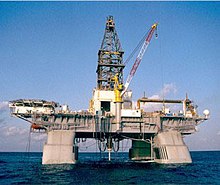Tiber oilfield
| Tiber Oil Field | |
|---|---|

The Tiber oilfield was drilled in 2009 by the semi-submersible oil rig Deepwater Horizon. The rig was destroyed as the result of an explosion 7 months after the discovery at Tiber, while drilling its next well at Macondo in April 2010.
|
|
| Location of Tiber Oil Field | |
| Country | United States |
| Region | Gulf of Mexico |
| Location | Keathley Canyon |
| Block | 102 |
| Offshore/onshore | Offshore |
| Coordinates | 26°52′42″N 93°16′06″W / 26.878333°N 93.268333°WCoordinates: 26°52′42″N 93°16′06″W / 26.878333°N 93.268333°W |
| Operator | BP plc |
| Partners |
BP plc (62%) Petrobras (20%) ConocoPhillips (18%<) |
| Field history | |
| Discovery | 2009 |
| Production | |
| Estimated oil in place | 4,000 million barrels (~5.5×108 t) |
| Producing formations | Lower Tertiary |
The Tiber Oil Field is a deepwater offshore oil field located in the Keathley Canyon block 102 of the United States sector of the Gulf of Mexico. The deepwater field (defined as water depth 1,300 to 5,000 feet (400 to 1,520 m),) was discovered in September 2009 and it is operated by BP. Described as a "giant" find, it is estimated to contain 4 to 6 billion barrels (640×106 to 950×106 m3) of oil in place. Although BP states it is too early to be sure of the size – a "huge" field is usually considered to contain 250 million barrels (40×106 m3). It required the drilling of a 10,685 m (35,056 ft) deep well under 1,260 m (4,130 ft) of water, making it one of the deepest wells ever drilled at the time of discovery.
Tiber comprises multiple Lower Tertiary petroleum reservoirs located in Keathley Canyon block 102 about 250 mi (400 km) southeast of Houston and 300 mi (480 km) south west of New Orleans. Tiber is only the 18th Lower Tertiary well to date, and drilling in these formations is in its infancy. The oil from Tiber is light crude, and early estimates of recoverable reserves are around 20–30% recovery, suggesting figures of around 600 to 900 million barrels (95×106 to 143×106 m3) of reserves. Sources such as Bloomberg suggest caution, warning that the find is technically complex and potentially could take 5–6 years to produce oil or be lower yield (5–15%) based on "rates talked about" at nearby Kaskida Oil Field, BP's previous giant find (2006) 40 mi (64 km) away. The commercial prospects of the field have not yet been evaluated.
...
Wikipedia

